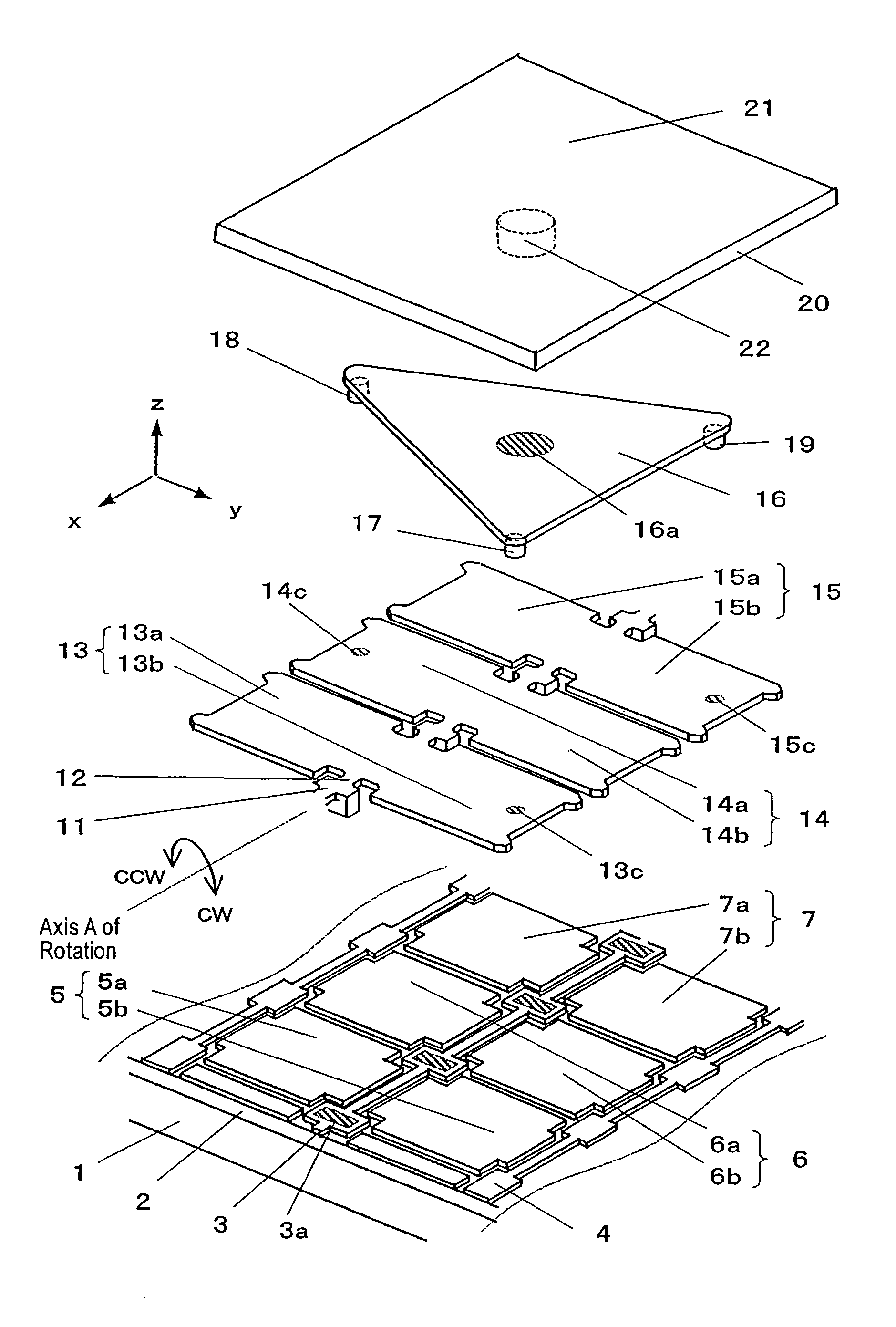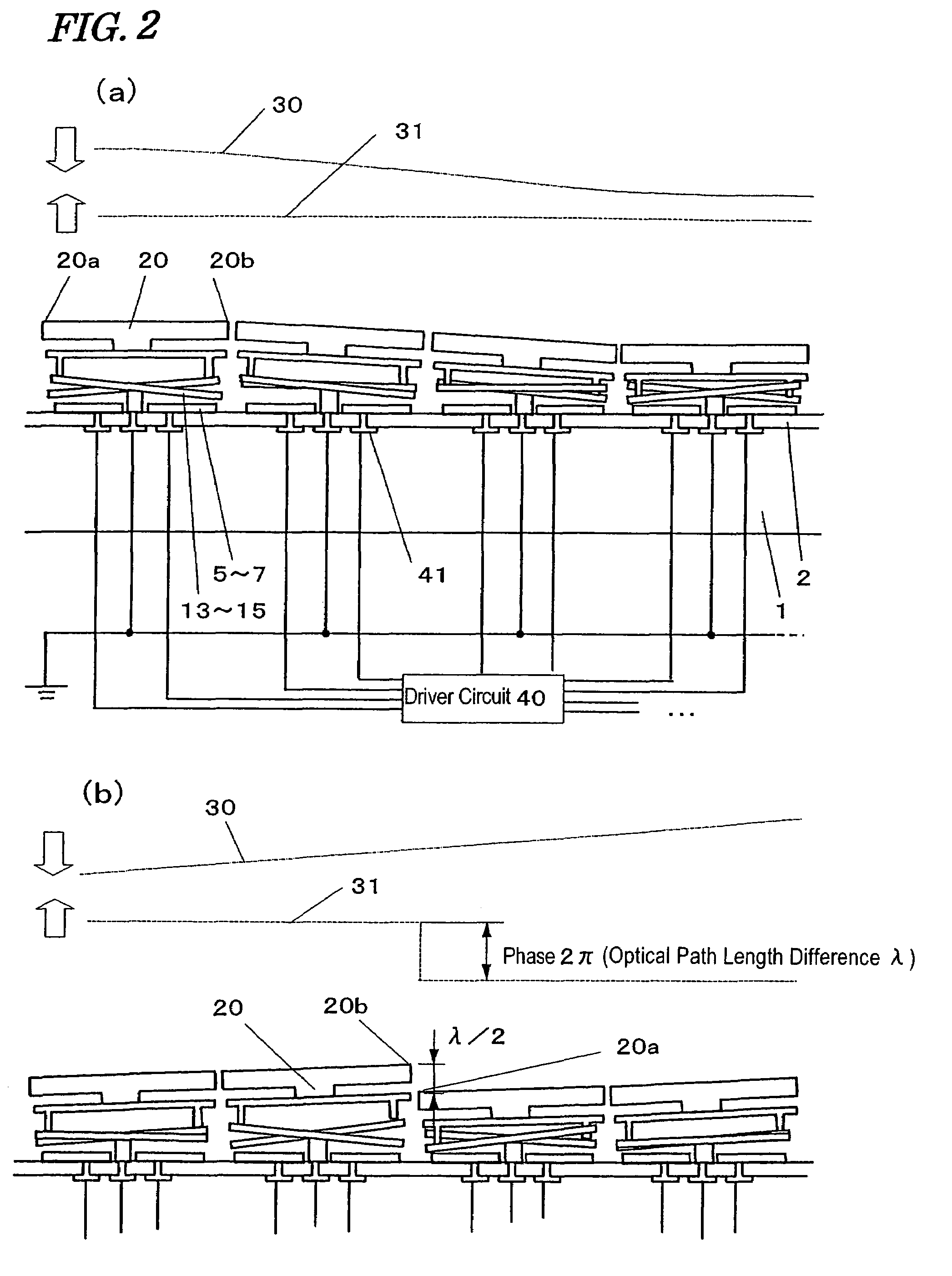Deformable mirror and optical controller including the deformable mirror
a technology of optical controller and deformation mirror, which is applied in the direction of optics, optical elements, instruments, etc., can solve the problems of reducing the response speed of continuous mirror, unable to obtain electrostatic force, and difficulty in ensuring the control range of continuous mirror and reducing the drive voltag
- Summary
- Abstract
- Description
- Claims
- Application Information
AI Technical Summary
Benefits of technology
Problems solved by technology
Method used
Image
Examples
embodiment 1
[0037]First, a deformable mirror according to a first preferred embodiment of the present invention will be described with reference to FIGS. 1 and 2.
[0038]The deformable mirror of this preferred embodiment has a configuration in which a plurality of actuators (i.e., driving sections) and a driver circuit for driving those actuators are integrated together on the same silicon substrate. This deformable mirror is preferably fabricated by semiconductor processing technologies.
[0039]Referring to FIG. 1, illustrated is an exploded perspective view of a deformable mirror according to this preferred embodiment. The deformable mirror of this preferred embodiment actually has a configuration in which a plurality of micromirrors (or reflective mirror elements) 20 are arranged in a two-dimensional array. In FIG. 1, just one of those micromirrors 20 and its associated driving section are illustrated on a large scale.
[0040]In the deformable mirror of this preferred embodiment, the driving secti...
embodiment 2
[0070]Hereinafter, a deformable mirror according to a second preferred embodiment of the present invention will be described with reference to FIG. 3. FIG. 3 is an exploded perspective view of a deformable mirror according to this preferred embodiment.
[0071]The difference between the deformable mirror of this preferred embodiment and the counterpart of the first preferred embodiment lies in the configuration of the intermediate coupling member 50. That is to say, the deformable mirrors of this and first preferred embodiments have the same configuration as for the substrate 1, insulating layer 2, base 3, yoke contact portion 4, fixed electrodes 5 to 7, supporting post 11, hinge 12, yokes 13 to 15, protrusion members 17 to 19, micromirror 20, reflective plane 21 and protrusion 22.
[0072]The intermediate coupling member 50 of this preferred embodiment includes three pairs of hinge portions 50b. Each hinge portion 50b supports its associated protrusion member 17, 18 or 19 in a freely rot...
embodiment 3
[0074]Hereinafter, a deformable mirror according to a third preferred embodiment of the present invention will be described with reference to FIG. 4. FIG. 4 is an exploded perspective view of a deformable mirror according to this preferred embodiment.
[0075]The deformable mirror of this preferred embodiment is different from the counterpart of the second preferred embodiment in the configuration of fixed electrodes 60, 61 and 62. More specifically, the first fixed electrode 60 of this preferred embodiment is divided into fixed-electrode pieces 60a and 60b, and each of the fixed-electrode pieces 60a and 60b is further subdivided into eight partial electrodes, to which drive voltages are applicable independently of each other. The following description will be focused on the fixed-electrode piece 60a, but the same statement is applicable to the other fixed-electrode piece 60b of the first fixed electrode 60 and to the fixed-electrode pieces 61a, 61b, 62a and 62b of the second and third...
PUM
 Login to View More
Login to View More Abstract
Description
Claims
Application Information
 Login to View More
Login to View More - R&D
- Intellectual Property
- Life Sciences
- Materials
- Tech Scout
- Unparalleled Data Quality
- Higher Quality Content
- 60% Fewer Hallucinations
Browse by: Latest US Patents, China's latest patents, Technical Efficacy Thesaurus, Application Domain, Technology Topic, Popular Technical Reports.
© 2025 PatSnap. All rights reserved.Legal|Privacy policy|Modern Slavery Act Transparency Statement|Sitemap|About US| Contact US: help@patsnap.com



